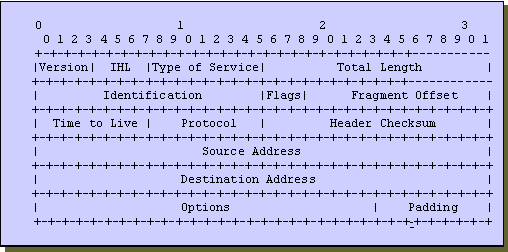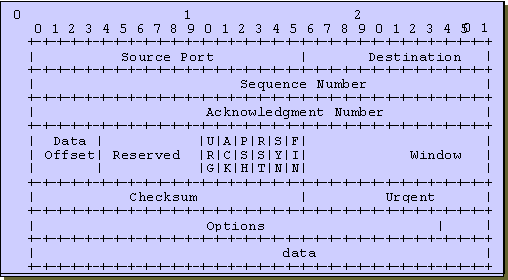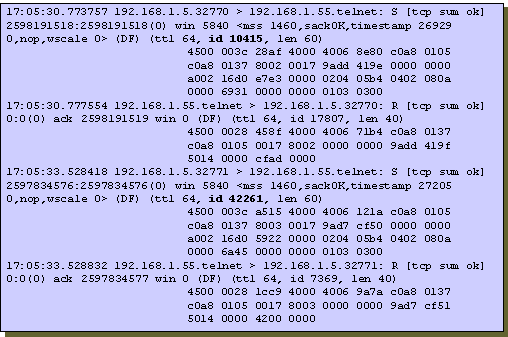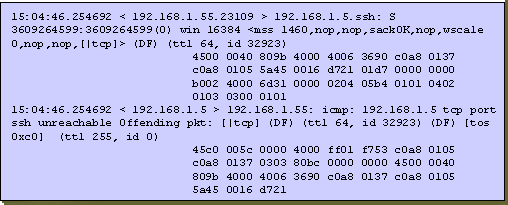
Figure 1: IP Header
1.1
PURPOSE
The purpose of this paper is to explain
the details and techniques that can be used in passive OS fingerprinting.
In this paper, we will look at packets captured by TCPDUMP. Although this
paper assumes the reader has a basic understanding of the Transmission
Control Protocol/Internet Protocol (TCP/IP), we will briefly cover certain
fields in the TCP/IP header. This paper will specifically cover passive
OS fingerprinting using TCP and the SYN packet. We will cover other flags
but the majority of the work has been done analyzing a SYN packet. Passive
OS fingerprinting using ICMP has been covered in great detail at http://www.sys-security.com/.
Before we begin, I want to clear up
any confusion between passive Operating System (OS) fingerprinting (what
we are doing here) and active OS fingerprinting (tools like NMAP use this
technique). First, passive OS fingerprinting does not send out any packets.
All that is needed to perform passive OS fingerprinting is a computer,
a sniffer and a desire to dig into a packet. Active OS fingerprinting on
the other hand will send special or not so special packets to a machine
and wait for a response from that machine. That response will determine
what operating system the remote system is running.
1.2
HEADER OVERVIEW
Before we cover passive OS fingerprinting,
let us look at the TCP and IP headers. Figure 1 shows an example of an
IP header.

Figure 1: IP Header
The first field we want to look at is the Type of Service field (TOS). The TOS field conveys the operating system and tells if there are any special requirements for the data. This field is like a quality of service field. For example, some operating systems will use the TOS setting 0x10 (minimize delay) for initializing telnet sessions. This can aid an analyst in identifying an operating system. By default many operating systems set their TOS fields to 00 (normal).
There has been a little confusion on the streets now about a new standard called Explicit Congestion Notification (ECN). This standard has changed the shape of our TCP/IP headers. In the past the TOS field was pretty simple, you had a precedence field (3-bits), a TOS field (4-bits) and a Must be Zero (MBZ) field (1 bit) for a total of 8 bits (1 byte). In the TOS service field a computer could set one of the following bits:
Two bits in the IP header that will be used are bits 6(left of the low order bit) and 7(low order bit) in the TOS field. Over the years, bits 6 and 7 have had various uses and meanings. Most recently, bit 6 was used by the TOS field and was defined as "Minimize Monetary Cost" with a hex value of 0x02. Typically, NNTP would use the TOS value 0x02, however this function became obsolete by the " Differentiated Services" field for IPv4 and IPv6. Bit 7 was set to MBZ (must be zero). Again, this function became obsolete by the "Differentiated Services" field for IPV4 and IPv6. As part of ECN, TOS bit 6 will now be used as an ECN capable transport (ECT). This bit will be set by the sender stating that the end points are ECN compatible [1]. Bit 7 will now be used as a Congestion Experienced bit (CE). This bit is set by routers that detect congestion on the network using Random Early Detection (RED). Through my experience though, I have not seen Red Hat Linux 7.1 use ECN in a SYN packet. This can be done if you recompile your kernel.For more information on TOS and the changes it has gone through over the years please see http://www.rfc-editor.org/rfc/rfc2474.txt. If you need more info on ECN please see http://www.rfc-editor.org/rfc/rfc3168.txt.
The total length field tells us how long the whole packet is. This includes the embedded header, IP header, and the payload. When I originally sent this paper out to be reviewed I had some discussions on the total packet length and its impact on not only passive OS fingerprinting but also intrusion detection. How? The total length of a packet is very dependent on the operating system (especially a SYN packet). Each operating system sets it's own TCP options along with nop's, these options affect the total length and therefore make each OS unique in total packet length. An operating system can be identified in some cases just by the packet length alone on the SYN packet. Also, when looking at TCP packets keep in mind that almost all operating systems use at least one TCP option on the SYN packet. Normally, this is the MSS option and that option is 4 bytes in length (making the minimum total length = 44 bytes). Therefore, if you are seeing a 40 byte packet coming in or out of your network… I would be hunting down the source because it is a crafted packet.
The third field we want to pay attention to is the IP ID field. This field is used mainly in fragmentation but can play a big role in passive OS identification. We will cover this field in much more detail later in this paper.
The Time-to-live (TTL) tells us how long a packet can stay on the wire. It is decremented by one for each hop (router) that the packet passes through. As you will see later in this paper, an initial TTL value can say a lot about an operating system.
There are a lot references out there that state that the DF field is a critical part in passive OS fingerprinting. Well, the DF field can be used to help identify an operating system but the problem is…most operating systems set the DF flag by default; therefore, this field becomes useless in identifying many operating systems.
Now that we have covered IP, let us
look at the Transmission Control Protocol (TCP) and its header. Figure
2 identifies what a TCP header looks like.

Figure 2: TCP Header
In the TCP header, we will want to begin by focusing on the source port field. This field can tell us some details about an operating system, but not enough to accurately identify the operating system. For example, a RedHat Linux system by default uses source ports that range from 1024 through 4999. However, if you are using NAT then you can throw that little piece of knowledge right out of the door. Why? This is because NAT will use high source ports.
Let us now look at the window field. This field tells us how many octets of data the sending computer is ready to receive. Keep in mind that once a connection has been made, this number can change depending on how much data needs to be passed. The initial window value can be different from operating system to operating system.
Finally, let us look at the most important field in the TCP header when it comes to passive operating system fingerprinting. This field is the TCP options field. This field by itself can almost identify most operating systems. Keep in mind that all of the operating systems I have researched use at least one TCP option in its SYN packet. Here is a list of the available options:
"It has two purposes: (1) indicate that the TCP is prepared to do both send and receive window scaling, and (2) communicate a scale factor to be applied to its receive window." [2]
1.3
OPERATING SYSTEMS
During my research, I tested the following
operating systems:
1.3.1
LINUX
Linux 2.4 and 2.2 are interesting
operating systems. Lets begin with a quick look at a TCPDUMP trace of a
Linux 2.4 SYN packet:

Figure 3: Linux 2.4 Packet Trace
Figure 3 is an excellent example of how a SYN packet can be a gold mine of information, when it comes to passive OS fingerprinting. Let us begin looking at the Window size. As we can see in Figure 3, Linux 2.4 sets its initial Window size to 5840 bytes. This is different from a Linux 2.2 kernel, which normally sets its initial window size to 32120.
Our next area to look at in this packet is the TTL. The TTL is great but it cannot identify an operating system by itself. By default, Linux kernel 2.2 and 2.4 use a default TTL value of 64. You can verify that value by issuing the following:
More /proc/sys/net/ipv4/ip_default_ttl
The IP ID is our next area of interest. Linux by default increments its IP ID by one during each session. BUT, it uses random IP IDs at the start of each new session. Let us look at some packets and see what I mean.

Figure 4: Linux Traffic
Take a look at the first SYN packet (attempted session), there we see an IP ID of 10415. If we look at the next SYN packet, we see that the IP ID is 42261. As I stated earlier, if a connection is not made then the IP ID's are random. However, once a connection has been established the IP ID that was used in the SYN packet will then be incremented by one during that session. Now, this trait makes Linux 2.4 interesting.
Our next field to look at is the TCP Options field. Take a look at Figure 5 and see what options TCP uses.

Figure 5: TCP Options
Figure 5 shows us a typical Linux 2.4 packet. If you look at the TCP Options (in bold), you can see that by default Linux 2.4 and 2.2 set the following TCP Options:
Since we brought up Total Length of a packet lets look at the Total Length of a typical Linux 2.4 packet. If you look at Figure 5, we see that the total length (in green) of the packet is 60 bytes. This is important, because Linux is the only operating system that I am aware of that has a total header length of sixty (60) bytes. Because of this trait, Linux is easy to identify.
1.3.1.1
Putting Linux Fingerprinting Together
In the previous section we covered
all of the default settings used in a Linux 2.4 stack and those settings
that can be used to identify Linux. Now we want to put all of that information
together and start identifying Linux "in the wild".

Figure 6: Linux packet
Looking at Figure 6, we see a few things that stand out.
1.3.2
OPENBSD
The second operating system we will
look at is OpenBSD. OpenBSD is considered the most secure operating system
on the market today. But, it also has a few characteristics that make it
easy to identify from a passive operating system perspective.
Lets begin this lesson by looking at Figure 7.

Figure 7: OpenBSD Packet
What makes OpenBSD easy to detect? Lets look at a few key indicators:
1.3.3
SOLARIS 7
Solaris is the next operating system
we will look at. By default, Solaris has one characteristic that makes
it easy to identify. That characteristic is the initial TTL field.

Figure 8: Solaris 7 Packet
Look at Figure 8 to see what kind of vital information we can gather from this packet:
1.3.4
AIX 4.3
AIX has some similarities to Solaris
and one to OpenBSD | Linux.

Figure 9: AIX packet
By looking at Figure 9 we can come up with these conclusions:
1.3.5
WINDOWS 2000
Our final operating system we will
be looking at is Windows 2000. Windows 2000 is really not that hard as
well to identify. Lets look at a Windows 2000 packet:

Figure 10: Windows 2000 Packet
By looking at Figure 10 we can come up with these conclusions:
1.4
CONTINUING RESEARCH
Until now we have focused on a plain
Jane SYN packet, you know the basics. During this study I found some other
interesting characteristics as well.
First, when testing these operating systems I wanted to see if using certain applications (i.e. telnet) could change the SYN. I tried FTP and nothing interesting came up, I tried telnet and I found two operating systems that set their TOS minimize delay bit during the initial SYN. Those two operating systems are OpenBSD and AIX 4.3. Figure 11 is an OpenBSD packet:

Figure 11: OpenBSD 2.9 Packet

Figure 12: AIX 4.3 Packet
In both figures we see that both AIX and OpenBSD set the minimize delay bit during the SYN. Ok, what's the big deal. Well, most operating system I have seen usually do not set TOS bits until after the TCP connection has been established. Knowing this we now have another piece of the pie to put together in passive OS fingerprinting.
During this research time, I began to sit back and wonder how we could identify operating systems using packets that do not contain a SYN flag. I began looking into this and found an away to identify AIX, Solaris and Microsoft Windows. Linux and OpenBSD can be identified but may require more then one packet to do so.
In order to do this we should break out a handy dandy PUSH | ACK packet and look at it:

Figure 13: PUSH | ACK packet
Lets take a closer look and see what's going on. First, of all we see that 192.168.1.5 is pushing 305 bytes of data across the wire. No big deal. Well, next lets look at the total length of this packet. This packets total length is 357 bytes. If you do the math and subtract 305 from 357, you will get 52. Linux and OpenBSD both have a header size of 52 bytes when pushing data across. How did I come up with 52 bytes? Well, look at the TCP Options in Figure 13. You can see here that this packet has 2 nop's set along with the timestamp option set. The Timestamp is 10 bytes in length and the nop's are one byte each in length for a total length of 12 bytes. The problem with Linux and OpenBSD is that both use the same TTL value. So in order to identify the two we would need to look at the IP ID. This would require us to look at more then one packet. Remember OpenBSD's IP ID are totally random. Therefore if we were to see random IP ID's during a session we could say that this is an OpenBSD box. Otherwise we are left saying that this packet is a Linux packet. (BTW, for FYI… this is a Linux machine.)

Figure 14: More PUSH | ACK packets
The packet shown in Figure 14 is different then the packet in Figure 13. How? Well, subtract the data being pushed from the total length. You will see a header length of 40 bytes. No TCP options, no nothing. This is typical of Windows 2000, Solaris 7 and AIX.
Finally, we have Red Hat Linux 7.1 and 7.2. Yes, I know that we have covered Linux but not this flavor of Linux. When a person installs Red Hat 7.1 or 7.2 he/she is given an option of setting up a default firewall. No big deal right? Wrong! Because of how Red Hat sets up the firewall, it provides us with a great deal of information to perform passive OS fingerprinting.
When installing a default load of Red Hat 7.1 or 7.2 the user is asked if he/she wants to set up a firewall. If the user is in a hurry and selects NEXT', then the default selection is Medium Security. This is bad! When set to Medium Security; Red Hat protects all resources below port 1023. Also, it does not allow access to the NFS Server (port 2049), X-Windows system (port 6000) and the X-font server system. What about ports 1024 -65535? Don't these ports count? Guess not. So, can you guess which firewall Red Hat chooses to use? I will help here. It's not IPTABLES. You guessed it correctly! It's IPCHAINS. Why? Well, that is a story for another paper. I bring this configuration up because instead of dropping the packets (like a good firewall should), Red Hat rejects the packets (using ICMP packets). This tells us a lot about Red Hat 7.1 and 7.2. Figure 15 shows us what I have been discussing:

Figure 15: Red Hat replie
In Figure 15, we see two packets. The first is a typical SYN packet that we have come to know and love. The second should be a RST or nothing at all (if using a firewall) but instead we see an ICMP TCP port SSH unreachable. How can we use this for passive OS fingerprinting? There are a couple of ways to use this. First, if you were sniffing and saw these replies only on ports below 1023 and RST's on ports above 1023 then you are probably dealing with a Red Hat machine with a default install. Second, the packet size for the ICMP packet is 92 bytes. During my research I have found that this is pretty consistent with this type of packet. Because of the default firewall setup that Red Hat uses we can easily identify a default Red Hat install on either a 7.1 machine or 7.2 machine.[3]
1.5
CONCLUSION
Although, I have not included all operating systems in this paper,
this should be a good start. If we can perfect this technique we can do
many things with the information (such as threat analysis). Passive OS
fingerprinting is a great tool to use but keep in mind that this technique
is not 100% spoof proof. Yet, most traffic that you monitor probably will
not be crafted to taint the fields used for passive OS fingerprinting.
So, it remains a very powerful method of identifying operating systems.
[1] http://www.rfc-editor.org/rfc/rfc2481.txt
[2] http://www.rfc-editor.org/rfc/rfc1323.txt
[3] I would like to thank Ofir Arkin and Jay Beale in helping
me with the research and discussions dealing with Red Hat 7.1 and 7.2 default
firewall issue.